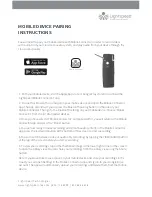
Chapter 2 Configuration
8
2.2 Configuring the Driver Software
The section describes the settings required for the driver software.
2.2.1 disable‑u320 property setting
The disable‑u320 property setting must be configured as shown below in the fjulsa driver
definition file. Adding the following line to the /platform/{sun4v│SUNW,SPARC‑Enterprise}
/kernel/drv/fjulsa.conf file makes the disable‑u320 property effective:
disable‑u320=0x1:
2.2.2 Property setting for each port
When the properties in the fjulsa driver definition file (/platform/{sun4v│
SUNW,SPARC‑Enterprise}/kernel/drv/fjulsa.conf) are set according to explanations in
Section 2.2.1, the property setting are applied to each port of all Ultra320 SCSI/SAS cards
mounted in the server.
To make the properties valid only for a specific port of a specific SCSI/SAS card, define
the properties as follows:
name= driver̲name
parent= /pci@##,####
unit‑address= #
The name of the adapter driver corresponding to the SCSI/SAS card is defined in driver̲name
of the name property. Specify fjulsa for the Ultra320 SCSI/SAS card.
The parent node of the SCSI/SAS card as named in a device name is defined in /pci@##,####
of the parent property. For example, if a device name shows that the SCSI/SAS card port
is
/pci@1d,4000/FJSV,(e)ulsa@3 , specify
/pci@1d,4000
.
The device number of the SCSI/SAS card in the device name is specified for # of the
unit‑address property. For example, if a device name shows that the SCSI/SAS card port
is
/pci@1d,4000/FJSV(e)ulsa@3 ,
specify
3
immediately
following
FJSV,(e)ulsa@ .
In the following example, the disable‑u320 is set to 0x1 for the port of an Ultra320 SCSI/SAS
card indicated as
/pci@1d,4000/FJSV,(e)ulsa@3
in a device name:
name= fjulsa
parent= /pci@1d,4000
unit‑address= 3
disable‑u320=0x1;
2.2.3 max‑throttle property setting
Some device such as disk drives can accept requests for multiple data transfers at the
same time. However, when the number of data transfer requests accepted by such a device
reaches the maximum number for the device, its queue becomes full, and the SCSI/SAS HBA
driver is notified of this status so that no more requests are sent from the driver.
Therefore, processing for data transfer requests is temporarily interrupted occasionally,
and data transfer efficiency decreases as a result.
The max‑throttle property of the fjulsa driver has been prepared as a means of preventing
this problem. By setting the max‑throttle property to a value below the maximum number
of data transfer requests that a device can handle concurrently, the number of data transfer
requests issued at the same time to the device is limited and a queue‑full state can be














































